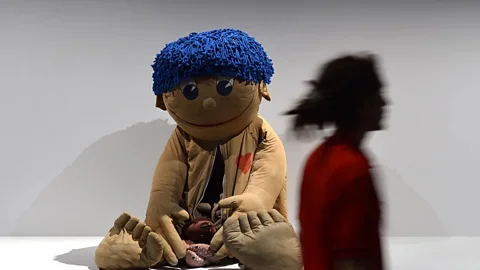Outsider art challenges conventions


‘Outsider art’ at the Venice Biennale challenges the commercialisation of contemporary art, writes Alastair Sooke.
Judging by all of the super-yachts moored along the city’s quayside, the Venice Biennale attracts a wealthy and exclusive audience. Wherever these floating pleasure palaces are moored, whole sections of pavement on the dock are fenced off, reinforcing the impression of a world reserved for the One Percent.
Although most of the work exhibited in the world’s oldest international art festival is not officially for sale, the Biennale offers an opportunity for oligarchs, movie moguls and other moneyed types to consider future purchases. If ever you doubted that the art world was the in-crowd, then visiting Venice during the Biennale provides the proof.
Yet this makes the focus of the main exhibition of this year’s Biennale all the more curious. The big theme of The Encyclopedic Palace, which features more than 150 artists from almost 40 countries, is so-called ‘outsider art’. The phrase usually applies to work with certain distinctive qualities, such as craft-based technique, a homespun appearance, and a dense and obsessive creativity coupled with a visionary strain. The people who make outsider art frequently suffer from psychiatric problems and may not describe themselves as artists at all.
Visitors to The Encyclopedic Palace, arranged across two locations in the shady parkland of the Giardini and the former shipyards of the Arsenale, encounter lots of art by self-taught eccentrics in this tradition – such as the American Morton Bartlett, who died in 1992. He left behind a collection of exquisitely handcrafted dolls carefully packed away in 30-year-old newspaper. Likewise the Russian-born Friedrich Schröder-Sonnenstern, who only started to produce phantasmagorical drawings using coloured pencils and crayons aged 57, having spent time in a Nazi labour camp during the Second World War.
The outsiders
And it isn’t only Venice where work like this is getting shown. Later this month, a new exhibition featuring several artists such as Bartlett who are appearing in The Encyclopedic Palace will open at the Hayward Gallery in London. “I find it exciting to confront imaginations that have been unharnessed a little more than the average person’s,” says the Hayward’s director Ralph Rugoff.
“Outsider art is very much in the air at the moment,” says the British gallery director Jonathan Watkins, who has curated the Iraq Pavilion, filled with unknown artists, in a palazzo on the Grand Canal at this year’s Venice Biennale. “The turbo-charged commercial art world is making some of us think again about what makes art fundamentally interesting. There is a critical mass of curators who want to remind people that there is something really interesting going on that has nothing to do with money.”
“Art is about artifice, and the biggest artifice is the art world,” says James Brett, the founder of The Museum of Everything. This self-styled “wandering institution” for untrained and undiscovered artists is holding an official affiliated exhibition at the Venice Biennale, showcasing 50 paintings by the shell-shocked WWII veteran, Italian artist Carlo Zinelli (1916-1974). “Contemporary art is about commerce, and as a result some essential creativity gets lost. In a strange way, the work we show at The Museum of Everything, which feels incredibly authentic, is a counter-balance to commercial contemporary art.”
But not everybody is a fan of outsider art. “It all looks like it was made by a single artist,” a British dealer says upon leaving The Encyclopedic Palace, referring to the fact that a lot of art of this nature shares the same folksy aesthetic. A respected British collector complains that promoting outsider art as the centrepiece of the Biennale is a “curatorial cop-out”, because it ignores more important artistic talents that would come to be seen as the defining voices of their generation.
Brave new world
For me, though, exhibiting outsider art at the Biennale is a brave thing to do. While most successful mainstream contemporary artists get picked up by powerhouse dealers, outsider artists are often detached from the infrastructure of the commercial art market. As a result, their work offers a backlash against the rampant commercialism that many people, such as the conceptual artist Jeremy Deller, believe is infecting contemporary art.
Inside his exhibition at this year’s British Pavilion, Deller includes a fantastical mural of the Victorian designer and social reformer William Morris. He emerges as a bearded colossus from the Venetian Lagoon in order to destroy Luna, a 377-foot yacht owned by the Russian oligarch Roman Abramovich that blocked the view from the Giardini at the last Biennale in 2011.
“A backlash against ever-increasing commercialisation is part of the story of the success of ‘outsider art’,” says Rugoff. “But it is also to do with a sense that contemporary art has become too ingrown. The imaginative range and conceptual ingenuity of work by mavericks, ‘outsiders’ and visionaries can make this conventional art world seem constrained and restricted by comparison.”
“For a decade or more, the art world has had a tendency to promote a lot of young artists right out of art school with perhaps too clever, sometimes quite slight ways of working,” explains the British artist Jeff McMillan, who is organising an exhibition of British folk art at Tate Britain next year. “The recognition of these ‘other’ artists of wild, unpredictable and sometimes brilliant ways of working is a correction of sorts – a reminder of what else art can be.” Wild and unpredictable – what more could you ask for from a work of art?
Alastair Sooke is an art critic for The Daily Telegraph
If you would like to comment on this story or anything else you have seen on BBC Culture, head over to our Facebook page or message us on Twitter.
